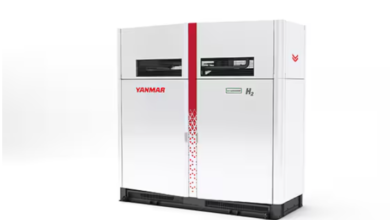Layer designs Croft system to power vehicles with hydrogen

Benjamin Hubert’s studio Layer has worked with US start-up Croft to design a system of products for retrofitting vehicles to run on green hydrogen.
The Nanoplant and Nanocartridges are the first prototypes from Croft, which is currently raising funds for the project, and enable users to produce their own solid-state hydrogen to power cars, trucks and other heavy-duty vehicles.
With an appearance similar to a large home battery, the Nanoplant uses electricity and water from the mains supply to carry out electrolysis — the splitting of water into hydrogen and oxygen.
The Nanoplant contains a pull-out drawer with room for four Nanocartridges, which store the hydrogen by sticking it to the surface of a proprietary particulate. According to the brand, this method stores the hydrogen densely and at low pressure, making it a safe solution that also gives more power and range than electric batteries.
According to Layer, Croft is “dedicated to creating a blueprint for an enduring, scalable, green-hydrogen economy” and offers its technology at a much lower cost than other hydrogen storage solutions on or near the market.
“Hydrogen stores significantly more energy in less space and with less weight than batteries, and it’s much easier to use hydrogen in environments with weak grids or where charging otherwise isn’t available.”
Hubert said that, at least in the short term, hydrogen would be a complement to electric vehicle technology, not a competitor.
“It’s a great complementary solution to batteries, and as with all things, it’s important to pick the right tool for the right job,” he continued.
To retrofit a vehicle with the technology, Croft removes most of the components of the power train and replaces them with its hydrogen storage system, a fuel cell, electric motors and other components, while reprogramming the vehicle’s onboard computer to utilise them.
The Nanocartridges weigh 14 to 16 kilograms and have four side handles, creating a cubic frame that can be easily gripped and stacked. A circular indicator on the top surface shows the cartridge’s remaining hydrogen capacity.
According to Layer, each cartridge has a range of 20 to 80 miles depending on the size of the vehicle and how hard it works.
“In addition to rapid fueling, cartridges also allow operators to carry additional fuel with them or receive rescue fuel if an asset gets stranded in the field, two features that today’s battery vehicles lack,” said Hubert.
The post-Layer designs Croft system to power vehicles with hydrogen appeared first on Dezeen.
